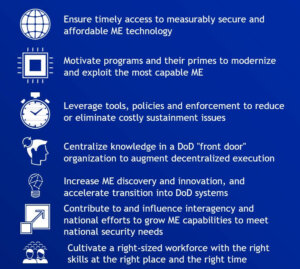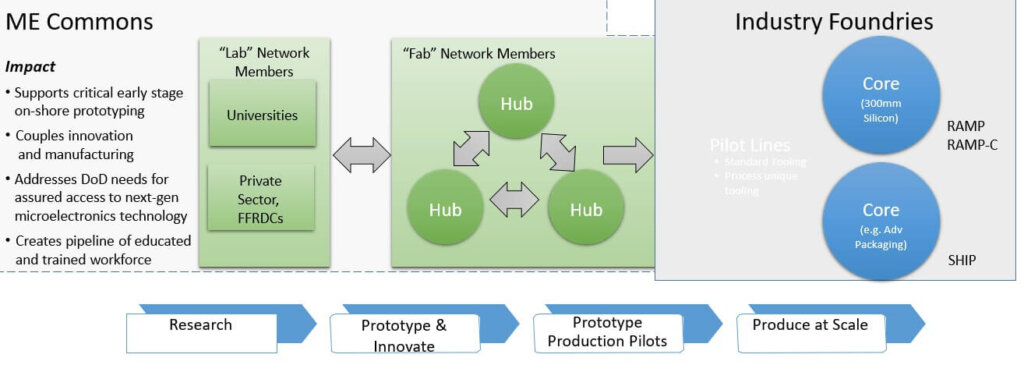IPC Expo – Defense Electronics Supplier Roundtable
The 16th Defense Electronics Supplier Roundtable at the recent IPC APEX EXPO in San Diego (Jan 2023) contained some interesting presentations that serve to add to our recent examination of the many government agencies currently looking to support Advanced Packaging.
Craig Herndon, DoD Executive Agent for Printed Circuit Board and Interconnect Technology (PrCB EA), gave a presentation on their activities and a look at “Key Issues Facing the Defense Electronics Industry”.
In the Office of the Under Secretary of Defense (OUSD), Industrial Base Policy is the focal point for all matters pertaining to PrCBs and interconnect technology. They have indicated that future funding may come via the Industrial Base Analysis and Sustainment Program (IBAS) (see IFTLE 547).
DoD policy states that the responsibilities of the DoD Executive Agent for Printed Circuit Board (PrCB) and Interconnect Technology should be to:
- facilitate access to reliable, trusted, and affordable PrCB fabrication and assembly products and technologies that meet the quality, performance, and security requirements of the DoD…
- Assess the vulnerabilities, trustworthiness, and diversity of the PrCB supply chain …
- Facilitate collaboration within and across the DoD to conduct research, development, and sustainment efforts targeting component-unique PrCB requirements…
- Develop and maintain a [DoD] PrCB and interconnect technologies roadmap…
2021 PrCB EA Report
The 2021 PrCB EA Report on DoD Access concluded that U.S. suppliers have an inadequate capacity to produce the advanced PCBs needed to enable continued miniaturization of DoD electronic systems and that U.S. suppliers lag by 5+ years compared to corresponding Asian (China, Taiwan, Japan, and South Korea) suppliers. The PrCB EA recommendations are to:
- Develop an investment strategy that will address gaps in U.S. advanced PCB technology and guide DoD decision-makers.
- Identify and communicate funding resources available to the U.S. PCB industry, such as the DPA Title III investments and Small Business Administration loans
- IC packaging should receive funding through the CHIPS Act, DPA Title III, and other government funding to support national defense systems.
- Financially motivate a major outsourced semiconductor assembly and test (OSAT) vendor to invest in domestic IC packaging capability as there is currently no production volume capability in the United States.
- Financially motivate a major IC substrate manufacturer to invest in onshore IC substrate manufacturing as there is currently no production volume capability in the United States.
- Invest in existing domestic PCB facilities with high-density interconnect capabilities to establish IC substrate manufacturing capability and capacity.
- Encourage DoD research to create U.S. sourced Dielectric materials.
- Component miniaturization necessitates changes to printed board assembly equipment/processes, with emphasis on component placement accuracy and solder application.
The critical issue that remains at the forefront is that the DoD is currently reliant on foreign un-trusted sources for global state-of-the-industry and state-of-the-art PrCB and interconnect products. They require some action to increase domestic capability and capacity in these areas.
Issues of Most Concern to the Industry
Based on an industry survey, Herndon reports that the major concerns are:
- The lack of domestic capacity to produce IC packages
- The lack of domestic capacity to produce advanced printed boards
- The shortage of IC components
- The lack of U.S.-sourced dielectric materials
- The need for printed board assembly equipment and processes that can support product and component miniaturization
- The consolidation of raw material suppliers, specifically laminates and dielectrics
- Trained manpower/aging workforce/incentives for younger generations to join the trade
TITLE III
 Let’s now take a look at this government operation known as “Title III”.
Let’s now take a look at this government operation known as “Title III”.
The Defense Production Act (DPA) authorizes the President to ensure the availability of U.S. and Canadian industries for U.S. defense, and essential civilian, and homeland security requirements.
Specifically, Title III provides for the “Expansion of Productive Capacity and Supply” through incentives to develop, maintain, modernize, and expand production capacity or critical technologies through loans/ loan guarantees; purchases/ purchase commitments; grants, and subsidies.
The execution requires the President to identify a domestic industrial base shortfall as meeting three specific criteria:
- The industrial resource, material, or critical technology item is essential to national defense.
- Without action, the US industry cannot be expected to provide the capability for the needed industrial resource, materials, or critical technology items in a timely manner.
- Purchases, purchase commitments, or other actions are the most cost-effective, expedient, and practical alternative methods for meeting the need.
Thus, agreed-upon needs in Microelectronics for Defense can also be supported by Title III funding.
Defense Microelectronics Cross-Functional Team (DMCFT)
Roger Smith of the U.S. Navy gave a presentation on the activities of the DMCFT whose goal it is to execute the DoD ME vision.

As we have discussed previously, one of the major DoD programs is “Microelectronics (ME) Commons” which will address domestic lab-to-fab requirements as shown below.

For all the latest in advanced packaging stay linked to IFTLE………………….





















